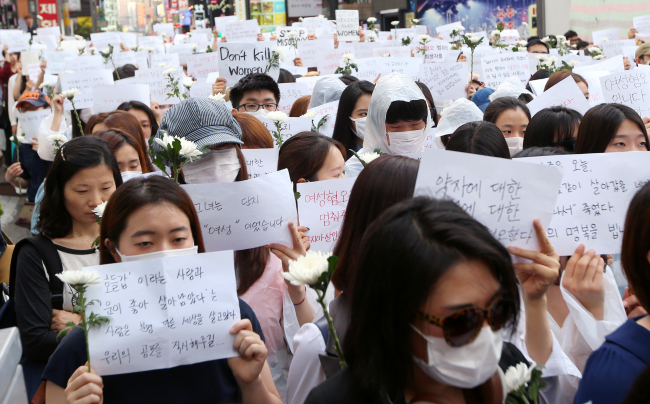South Korean police concluded Sunday that the recent murder of a 23-year-old woman in southern Seoul was a random crime by a man suffering from mental illness.
The Seoul Metropolitan Police Agency said in a press briefing that the killing by the 34-year-old man, only identified by his surname Kim, was a typical crime committed by the mentally disturbed.
Kim was arrested last week on suspicion of stabbing the woman to death at a public bathroom near Gangnam Subway Station on May 17. He allegedly waited until other six men left the toilet and killed the first woman who entered, according to CCTV footage.
 |
Sergeant Lee Sang-gyeong of the Seoul Metropolitan Police Agency speaks during a press briefing at Seocho Police Station in Seoul on Sunday. (Yonhap) |
The suspect, who had no prior contact with the victim, told police that he had committed the crime because he had been “belittled” by women many times in the past.
Police pointed out that killing the first woman Kim saw in the toilet meant that his crime was neither planned in advance nor systematic.
“There is a need to distinguish between hate crimes and crimes driven by mental illness. The latest case falls in the latter category,” the police said in a press briefing. “Hate crime arises from prejudice on a certain group, while mental illness-driven crimes are usually committed due to symptoms such as delusional thoughts and auditory hallucination.”
After police profilers had hours-long interviews with Kim on two occasions, they concluded that the crime was “accidental” as the suspect had no direct cause to murder the victim and his symptom of schizophrenia had deteriorated at the time of the crime.
According to the police, Kim, who was an only child, has lived alone without interacting with his family. He used to work with women at a restaurant as a waiter, but had to move to the kitchen for his personal hygiene problems, which Kim claimed was due to his female colleagues badmouthing him.
He allegedly told the police that he could not stand mistreatment by women anymore and had to kill them before he got killed.
Since 2008, he has shown abnormal behavior such as not having a shower for over a year, sleeping on the streets or smashing the front door of his house without being aware of his mental illness, police said.
Kim was hospitalized for schizophrenia six times since 2008. But he never took medication since he was discharged from the hospital in January, which police claimed might have prompted him to commit the crime.
In Korea, there are an estimated 500,000 patients suffering from schizophrenia, but only 104,000 visited hospitals for treatment.
According to prosecutors’ data, 36 percent of impulsive crimes between 2012 and 2015 were committed by those with mental illness, followed by alcohol and drug addiction at 36 percent and dissatisfaction with reality at 24 percent.
As part of efforts to prevent crimes by the mentally ill, the police has been granted more authority to order the mentally disturbed to be admitted to hospitals when they detect any abnormal behavior. The revision to the mental health act passed at the National Assembly last week despite lingering concerns over possible human rights violations by authorities on the mentally ill.
The police conclusion on the nature of the crime, however, sparked further public outcry and concerns among experts and Koreans who continued to mourn the death of the young woman at a makeshift shrine outside exit 10 of Gangnam Station on Sunday afternoon.
 |
Participants attend a tribute march for the victim of the Gangnam murder on Saturday. (Yonhap) |
“It is impossible to define the cause of crime as either mental problem or hatred against women. Many experts should come together to study his mental problem more in-depth,” a lawyer Go Ji-woon from Gamdong law firm told The Korea Herald.
“Despite his mental illness, he might have unconsciously developed hatred against women. Without considering the social atmosphere, defining his crime as stemming from solely mental problem can cast doubts on the probe.”
“I cannot trust the police anymore. I don’t think police can solve violence against women any longer. It seems that the police are trying to cover up the case to make it not look like a hate crime,” Kim Eun-ji, 25, said. “Not to mention, the police labelling the case as ‘crime by the mentally ill’ might create prejudice for those suffering from mental problems.”
Tensions were running high around the subway station as male protestors wearing a mask and holding up placards reading “Not all men are potential murderers” and “The crime was not misogynist” clashed with mourners and activists at the scene.
Park Byung-hak, 36, who was browsing post-it memos on the wall, slammed the police for seemingly denying the misogynist nature of the crime.
“I guess that police analysis on the criminal motive is an obvious error,” said Park, who came to the scene for the first time since the incident took place. “I think that Korean society is just too used to gender-based discrimination and violence against women.”
By Ock Hyun-ju (
laeticia.ock@heraldcorp.com)








![[Today’s K-pop] Blackpink’s Jennie, Lisa invited to Coachella as solo acts](http://res.heraldm.com/phpwas/restmb_idxmake.php?idx=644&simg=/content/image/2024/11/21/20241121050099_0.jpg)
